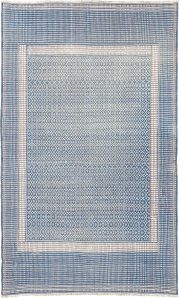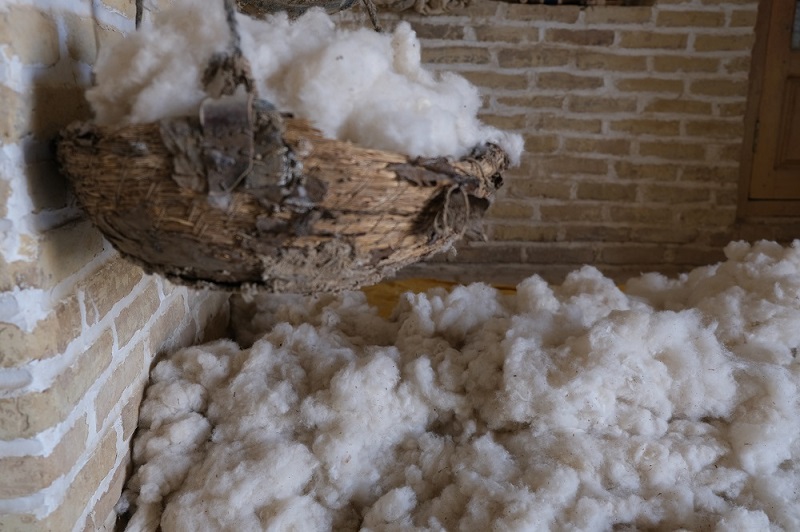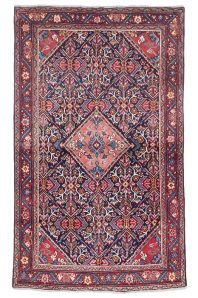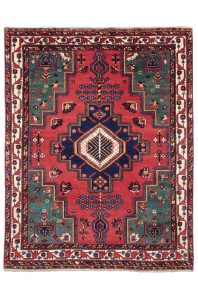
ZILU , COTTON HERITAGE

This article is a research based on an academic thesis, presented in 2011 in which Reza Abbasi have tried to revive the origins of forgotten zilu patterns , reproducing them on large size rugs with natural dyed materials (article is printed in Hali magazine issue 208) It’s not possible to determine exactly the first origination of art of Zilu Weaving. Because there is no exact history and written sources do not have enough information from which to examine the historical records of the ...
This article is a research based on an academic thesis, presented in 2011 in which Reza Abbasi have tried to revive the origins of forgotten zilu patterns , reproducing them on large size rugs with natural dyed materials (article is printed in Hali magazine issue 208)
It’s not possible to determine exactly the first origination of art of Zilu Weaving. Because there is no exact history and written sources do not have enough information from which to examine the historical records of the type of carpet. Zilu is mentioned in limited sources, for example, Naser Khosrow’s travelogue and the book Hudood al-Alam THE REGIONS OF THE WORLD, a Persian geography. Given that these writings also provide little information about post-Islamic zilu, some believe that Zilu Weaving is influenced by mat weaving and the evolved stage of mat weaving.

- Zilu Museum
- Meybod Museum of Zilu is located in the renovated caravanserai of this city, next to the old Icehouse and ancient pony express house building. This exquisite collection has valuable zilu. Existence of a large old zilu loom with a width of 5 meters, adds to the importance of this museum, the oldest existing Zilu belongs to the year 808 AH.

- History of Zilu
- From ancient times the wool and skin of animals were used as covering material, but it was not always possible to obtain it by hunting. Because it would soon rot and disappear. So people urgently needed to invent of a material that could replace it. The first logical step was to make zilu instead of animal skin and wool. Such a zilu, in which pieces of red wool are woven, is still found among Kyrgyz nomads. (Pope, 2535, p. 273)
- Also, the existence of various artifacts on the Iranian plateau, including a fossil of a mat belonging to 5500 BC, discovered in the city of Shahdad, Kerman, shows the antiquity of the bedding in this land. Zilu, which has a similar texture to mats and is used as a mat. It was probably the evolution of mat weaving, and Zilu weavers were inspired by the mat weaving industry. This valuable carpet, the origin of which is not clear, has been one of the important arts of Iranians, which is considered as one of the Iranian handicrafts in terms of the use of materials and methods of preparation, as well as its original and unique designs.
- In the travelogue of Naser Khosrow, when describing the mosques of Sham(Levant) to Shirvan, it is stated that: From Sham(Levant) to Shirvan, in all cities and villages, every mosque that existed had many lanterns, mats and many zilu. In another part of Naser Khosrow’s travelogue, it is stated: We reached the Toun(Ferdows) city, it was a big city. It has a river and a canyon, and on the east side there were many gardens and a strong fence. It was said that there were four hundred workshops in this city where Zilu was woven. (Naser Khosrow, (1370, p. 111)
- Another important historical source that belongs to the fourth century AH is Hudood al-Alam, which was written in 372 AH . This book considers Zilu as one of the major products and commercial goods of the cities of Azerbaijan, Fars and Sistan: Vartan is a city with many blessings and Zilu and Praying halls rise from it. (Hudood al-Alam, 1372 p.417)
- Arthur Pope also said: “The name of one of the cities where both zilu and prayer rugs were woven was Vartan. Many zilows were woven in the cities of Khoy and Nakhchivan. Mostly were woven in blue and white colour , words are written in kufic script in the borders of the Zilu (Pope, 2535, p. 275).
- In another part of Hudood al-Alam, it is stated in the description of Sistan: Sistan is a region that its people call it “Zarang”. It is a city with a fence and around it there is a moat from which water comes and there are rivers and the city has five iron gates, in Jahrom there are many zilu’s and dried dates. (Hudood al-Alam, 1372, p. 319)
- The old Zilu dates back to 963 AH and is now housed in the Islamic Museum in Cairo. Apparently, this sample is one of the fourteen Zilu that were donated in the same tenth century AH in Nourieh Monastery of Taft city (south of Yazd). This zilu, which is in Cairo, is woven with a length and width of 900 and 400 cm. Its main background is covered with rhombus-shaped patterns and repetitive polyhedrons. In the inscription on the margin of Zilu, the phrase “His Majesty Nawab” has been used as the customer of Zilu. It should be noted that historically, the word “Nawab” indicates that these Zilu were woven by order of a member of the Safavid royal family. Khanesh Begum is the name of two Safavid princesses, one of whom is the sister and the other the daughter of Shah Tahmasb. Both of these princesses are related to the relatives of Shah Nematullah Vali. According to the inscription of Shah Vali Mosque of Taft city, documents of which have been obtained from that city, the name of the builder of the mosque is “Khanesh Begum, Shah Tahmaseb’s sister and Shah Noureddin Nematullah Baghi’s wife”.
- – Richard Etinghausen, a German-American historian who has several books on Islamic art, talks about another zilu that was available in the Tehran bazaar in 1333 and in his inscription it was mentioned that this zilu was dedicated to the Nourieh monastery of Taft city. Date 963, as Etinghausen mention; The pictures of the floor coverings with geometric decorative patterns that can be seen in the Timurid paintings of the Herat school, may be related to carpets or felts and tiles before the Safavid period or even zilu with that pattern. He believes that even if these designs are only related to carpets, they are probably used in zilu as well. Even today, in the Yazd zilu, we see the repetition of those patterns.
- Thus, it can be concluded that Zilu is a cotton floor covering for mosques and prayer halls and was woven in Yazd, Meybod, Ardakan and Taft cities for at least more than four centuries AH. The sample in Tehran Carpet Museum is one of the 14 Zilu ordered by the Safavid princess Khanesh Begum , woven in Taft in 936 AH, is one of the oldest and most valuable examples available.
- Calligraphy and inscription in Zilu
- Another feature of Zilu is the presence of inscriptions in this carpet. These inscriptions, like Zillow’s designs, show a kind of cultural and social behavior of Iranians. Belief in good deeds and public works, attention to religious issues, historical records, interest in the permanence of letters and exposing them to the public, can all be examined in the inscriptions on the margins of the ziu.
- The inscription of the zilu has also helped to know and study the history of the zilu. In these inscriptions, the date of execution of the work, the name of the client, the name of the weaver and the name of the place where Zilu is spread are mentioned. In many cases, the date of construction of the building can be guessed based on the dates in the dedicated zilu and descriptions of the inscriptions, which in itself is a great help to the historical study.
- Another important point is that in the behavioral culture of Iranian artists and craftsmen, less attention has been paid to the artist’s signature and name. As we encounter many Artworks today without the slightest knowledge of the name of the creator of the work. Zilu Weaving is one of the few arts in which the name of the artist is always mentioned next to the name of the customer, and today it has made it possible for the names of its artists to be studied and researched in the study of different zilu. Another important point in examining the inscriptions is its aesthetic structure. Another important element in examining the inscriptions is its aesthetic structure. Zilu, as a carpet that has similarities to Islamic architecture and its decorative elements, has maintained this harmony and synchronicity in inscription as well, has caused what was spread on the walls and ceilings of the building, reflecting on the ground as well and put the architectural space in a harmonious balance.

Zilu in the traditional colourway.
Persia, ca. 1940 , 2.90 x 5.08m
Courtesy FJ Hakimian , New York
- Zilu, in spite of other carpets produced in Iran, has little color variety. This simplicity has made the zilu harmonize with the architecture of the place it has covered, particularly blue and white zilu which are inspired by tile-works and plasterworks of Islamic architecture.
- The colors used in Zilu, like other materials, were produced in the area. The raw materials of those colors were generally rosin (for the colors of the red spectrum), indigo (for the colors of the blue spectrum), walnut skin (for the colors of the brown spectrum).
- These colors were of plant origin, were stable, and showed great resistance to sunlight and washing. As mentioned, the old Zilu still retain their color despite the passage of centuries. Zilu are generally divided into three groups in terms of functions and colors:
- 1. Blue and white zilu with which it is dedicated to mosques and holy places.
- 2. Zilu with blue and red colors that are used for home use.
- 3. Zilu with green and red colors, which is the best type of zilu.

- A study of the written culture of zilu
- The part of the zilu that was used for writing is the large margin part of this carpet, which gave a beautiful structure to the it with different writing variations. The script used in Zilu was also a type of “Naskh” , some of the letters of which have similarities to the “Sols” script.
- Zilu Inscription can be divided into several sections:
- How to dedicate Zilu, which is mostly written in short sentences and phrases.
- Another noteworthy part of Zilu inscriptions is the nicknames and titles that introduce the donors.
- Another factor that attracts attention in Zilu’s inscriptions is the reasons for Zilu’s endowment, and because carpets have a high durability, handwriting acted as a document.
- Another Important thing in Zilu’s inscriptions is the special places where it was donated. Parts and places of mosques and tombs of scholars and scientists to which Zilu was donated.
- Another important feature of Zilu that is mentioned in the inscriptions is the signature of the masters, based on which the works of different masters of this art can be identified. In some zilu, the weavers also write their name in alphabetical letters, or write their name in a smaller form in the corner of the inscription. In some cases, weavers use the name of their father or grandfather in addition to their name. Most of the masters who were the children of famous weavers, mentioning the name of their father or grandfather, reminded of their mastery. For this reason, sometimes even the name of the father or grandfather took precedence over the name of the weaver, and thus the mastery and great precedence were maintained. In addition to the names of weavers and donors of zilu, the names of other people are mentioned who actually made the carpet with their efforts. These people were mainly the builders of mosques.
- Another unique feature of Zilu inscriptions is the mention of the date of weaving that was written at the end of the inscriptions. These dates were always written in Hijri lunar calendar and this tradition is still common today. The date of weaving was written in several ways, and in some zilu, the date was placed after the word “Saneh”. In some, Date was written entirely in letters. In some other zilu, in addition to writing the letters, the date was also mentioned as a number. It is worth mentioning that in most zilu, the month is written in letters and the year in numbers.
- Poems and prayers are other things that are mentioned in some inscriptions. In these poems and prayers, the reader of the inscription is asked for a good prayer and a good end, a long life, a life with peace of mind and a prayer for the souls of the dead. These expressions reflect the depth of the cultural beliefs of donors and weavers. As in everyday life, such desires and demands are always repeated among the people of the street and the Bazaar.

- Aesthetic functions of motifs in Zillow
- The variety of motifs is another interesting aspect of Zillow, which, while being visually appealing, has a rich and fruitful culture. These motifs are mainly derived from the culture and social environment and life of the people on the edge of the desert, which shows the richness of the fertile thoughts and ideas of designers and craftsmen who have seen a beautiful pattern in the smallest details that can sit on the carpet and beautify that pattern. They have also diversified it. Plants, animals, architecture were all signs that could be used to make a role and fit the zilu everywhere. Simple patterns that can be easily understood from the culture, customs and clothing of the people of Yazd. These motifs can be divided into three parts:
- 1. The first category includes patterns that can also be seen on carpets such as carpets and kilims. Especially carpets that use more Geometric patterns, such as kilims. But it is not clear which one affected the other. It is important to note that what can be seen today is the similarity of the patterns used in Zilu and other types of Persian carpets.
- 2. The second category are patterns that have an integral connection between Zilu and decorative motifs of Iranian architecture and in some cases have common names. These motifs also have a long history in Iranian art and the background of a large part of them, Iranian art and civilization. But due to the lack of sufficient resources, it is not possible to clarify exactly when these motifs were introduced in Zilu and for the first time in which region of Greater Iran this change took place.
- 3. The third category is the designs that are dedicated to Zilu Weaving and cannot be found in any of the other decorative arts. This group forms a large part of the motifs and shows the initiative of masters and designers in creating various and creative patterns, which has made this carpet beautiful and unique in motifs. These patterns mainly have local names that originate from the environment and geography of Yazd, and naturally it is necessary to know them to be familiar with the spoken culture of the people of Yazd, especially Meybod and Ardakan.
- To conclude, cotton rugs are not only the preliminary sort of floor covering in Iran, also can be considered as a necessity in desert life and other regions, so far as its spread has reached to other middle eastern countries such as turkey and Syria in which similar type of rugs can be found.

reference: A Survey on Yazd’s Rugs (zilu)
Javad Ali-Mohammadi Ardakani




that’s great